Headwaters of Ideas and Information:
Tracing the Technology Flow
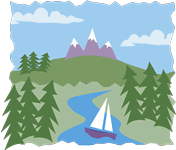 How do I help young people distinguish fact from fiction when the lines drawn by news and entertainment are often blurred? How do I determine the origin of information found on the web? What skills are needed to weigh arguments and draw conclusions? How are wikis created? Should wikipedia be used as an information source?
How do I help young people distinguish fact from fiction when the lines drawn by news and entertainment are often blurred? How do I determine the origin of information found on the web? What skills are needed to weigh arguments and draw conclusions? How are wikis created? Should wikipedia be used as an information source?
The key to addressing these questions lies in helping students understand the inquiry process, how ideas are generated, and the process of tracing the origin of information. This session provides practical ideas and examples to help students manage the technology, evaluate information, and synthesize ideas to become information fluent.
"Learning and teaching should not stand on opposite banks and just watch the river flow by; instead, they should embark together on a journey down the water. Through an active, reciprocal exchange, teaching can strengthen learning how to learn." - Loris Malaguzzi (1920-1994), Italian early childhood education specialist. From The Hundred Languages of Children by Carolyn Edwards (1993).
The Headwaters
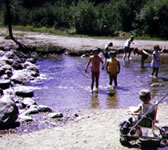
The origin of a river is called the headwater. Although the river may flow for thousands of miles, the headwaters is where the river begins. Like information, the waters change as they flow through mountains, meet with other rivers, and pass through polluted cities. To find the pure water (or ideas) you need to seek the source.
Read books about survival such as Lost: A Tale of Survival by Chris Kreie from Stone Arch Books. The graphic novel is a great way to engage young readers. Consider a literature circle that also includes My Side of the Mountain by Jean Craighead George, Hatchet by Gary Paulsen, and other tales of survival.
Explore Internet resources about survival in the wilderness. Which do you believe? Why? As you evaluate information think about the source of the information. Who said what? Why? Start with Survival for Kids.
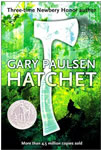


Young people need experiences working with evidence. Rather than looking for an "answer," they need to be able to work their way along the streams of information to find the headwaters (origin of the ideas). Then, make an informed decision. This process involves collecting evidence, analyzing evidence, challenging evidence, and applying evidence to make a decision, solve a problem, or draw a conclusion.
Let's explore an example for younger children. What do you call a baby mouse? Conclusion? There are at least three answers to this question.
- Webster's Dictionary - pup
- Wikipedia - pup
- Wikipedia - baby animal names - pinkie, kitten, pup
- Christchurch Public Library - pup, kitten
- Enchanted Learning - pup, kitten, pinkie
- Mice by Kevin J. Holmes - kitten
- Pinky Is a Baby Mouse by Pam Muñoz Ryan - pinky


Collect Evidence
 When young people are conducting inquiries, they're often searching for evidence that might be used in addressing questions, solving problems, or making decisions. Rather than simply reporting the first answer they find, it's important to discuss the importance of collecting evidence to support multiple views before making a decision. Use the analogy of the chair. A chair must have at least three sturdy legs or it will fall over.
When young people are conducting inquiries, they're often searching for evidence that might be used in addressing questions, solving problems, or making decisions. Rather than simply reporting the first answer they find, it's important to discuss the importance of collecting evidence to support multiple views before making a decision. Use the analogy of the chair. A chair must have at least three sturdy legs or it will fall over.
Involve students in collecting data from different locations and discussing the origin of the data. Go to ZipSkinny. Where did this data originate? Compare this data with information found at the US Census.
Primary sources are original objects, documents, records, and other materials that have survived the past. They represent a direct personal experience at a particular point in time.
Secondary sources document or interpret events at some time after the actual event. Primary sources are used to create biographies and other nonfiction trade books.
Third-level or tertiary sources are compiled from a broad spectrum of documents. These include textbooks and encyclopedias.
So... what's a website? It depends on it's origin. You need to work your way back from the "stream" of information you find on the Web to find the source of the information. Keep in mind that all sources of information can be filled with bias, misinterpretation, and misunderstandings. Young people must learn to challenge evidence!
Practice collecting evidence by working on a Wikipedia page. Begin by conducting a Wikipedia search for your hometown. Are quality sources used to provided to support the statements in the article? What's fact and what's opinion? Can you provide additional examples or references?
Go to Articles Lacking Sources. Select an article and locate resources to support the content of the article.
Consider the different types of evidence listed in Black’s Law Dictionary include:
- Evidence – Testimony, writings, material objects, or other things presented to the senses that are offered to prove the existence or nonexistence of a fact.
- Expert evidence – Testimony given in relation to some scientific, technical, or professional matter by persons qualified to speak authoritatively by reason of special training, skill, or familiarity with the subject.
- Tangible evidence – Physical evidence; evidence that can be seen or touched such as documents or weapons.
- Testimonial evidence – Communicative evidence from a witness or expert.
- Demonstrative evidence – Tangible objects that help to illustrate or explain oral evidence.
Seek out WebQuests that involve students in decision-making based on evidence. For example, explore the Can You Hear Me Now? WebQuest for 9th Grade Algebra.
Use the Library Arcade Game to get young people thinking about resources. People patrons find the best resource to match their question.
Analyze Evidence
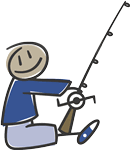 Although young people aren't expected to be judges, they do need to be legal and authority-minded. They need to question the authority of information they find and seek out second opinions and alternative perspectives.
Although young people aren't expected to be judges, they do need to be legal and authority-minded. They need to question the authority of information they find and seek out second opinions and alternative perspectives.
According to Daniel Callison, "as the student matures in Information Inquiry, proof of an argument or a claim should become a natural reaction to any opinion, observation or data, regardless of the original source."
When people say "The Nuclear Age," what do they mean? Do a Google search for nuclear age view:timeline. For more information, go to Google Experimental Search - Timelines




Books
- The Green Glass Sea by Ellen Klages
- The Gadget by Paul Zindel
- The Ultimate Weapon: The Race to develop the Atomic Bomb by Edward T. Sullivan
- Marie Curie and Radioactivity by Connie Colwell Colwell Miller, Scott Larso
Websites
- Nuclear Age by 42explore
- The Manhattan Project
- The Manhattan Project: An Interactive History
- Manhattan Project from Wikipedia - use their resources and visuals (Wikimedia Commons)
- Interactives
- Radiation - Hanford at the Half Life Radiation Calculator.
Science Resources
What's so new that your parents didn't learn in school?
- Science Daily
- Live Science
- New Scientist
- Science Central (Video section)
- PNAS in the News
- National Geographic News
Challenge Evidence
 Regardless of whether the information is found in a book, television program, electronic database, or website, students must learn to challenge the information they find. Attractive news anchors, engaging images, and colorful prose can easily draw students into believing almost anything.
Regardless of whether the information is found in a book, television program, electronic database, or website, students must learn to challenge the information they find. Attractive news anchors, engaging images, and colorful prose can easily draw students into believing almost anything.
Ask young people to challenge the information they find. Start with controversial issues. Go to the List of Controversial Issues from Wikipedia. Using the Aspartame Controversy from Wikipedia as an example, work your way down the "The Capital Cs to Challenge Evidence."
Daniel Callison and Annette Lamb (2006) developed "The Capital Cs to Challenge Evidence" to help young people become wise information consumers by challenging the information they see and hear.
Common. Is this information Common knowledge and not in need of verification?
Conventional Wisdom. Is this information a Commonly held assumption or belief, but in need of verification as majority opinion is not necessarily Correct? Conventional wisdom will Change over time and across events and is very much influenced by political Correctness.
Corroboration. Does this new evidence Corroborate previous information from another source and help to Confirm the notion held by the inquirer? As a second or third source, does it add strength to an argument by validating the earlier opinions or evidence gathered?
Circumstantial. Although not direct and tangible proof, does this evidence provide Convincing observations or facts that one can reasonably infer in support of a Conclusion? Is the substantial evidence drawn from logical reasoning?
Cherry Picked. Has the evidence presented in this resource been selected to argue only one side of the issue? While some of the facts and opinions may be relevant, is it clear that author has selected only the evidence that agrees with his side of the argument? Are you giving Care to the selection of your own evidence so that you do not become closed minded to other options and weigh the evidence from several perspectives. Cherry picking is often a technique to gather evidence that an underling believes his or her boss wants to hear or to support a decision already made, no matter how poorly Conceived.
Comforts. Does this evidence give Comfort to the inquirer because it supports the Current held notion? Should the inquirer beware of accepting evidence simply because it seems to agree with what the inquirer believes, wants to believe or wants to be true?
Chains or Connects. Is the evidence a useful part of the Chain of evidence linking facts and observations Collectively to make an argument in support of a Claim or notion? Does it Clarify and add value to the meaning of the other evidence? Are there a reasonable number of good sources Cited in the document to at least believe the author has reviewed many documents relevant to the issues and has Connected them to make his or her Case?
Counters, Convincing and Changes. Does this new evidence Counter previous information found from an earlier source or opinion held by the inquirer? Is it more Current or more Convincing? Will this piece of evidence Convince naysayers that are unlikely to be swayed by the other evidence found so far? Is this evidence so strong and so conclusive, that it is likely to support a particularly difficult to accept point of view? Is this new information so impressive that it Changes the notions held by the inquirer in some manner? It may stand alone an independent, but very Convincing piece of evidence.
Credible. Based on the Credentials given of the source and author of the evidence, the methods used to establish the evidence and, if necessary, the respect held for the information source and author by the inquirer’s mentors, is it reasonable to accept the evidence as Credible? In the case of opinions, credibility may rest with the position of the person expressing the opinion. Remember that politicians and editorial writers are no necessarily experts on the many subjects for which they offer their opinion. These Comments may represent the viewpoint of a certain group or position, but options can be expressed widely in our society without providing evidence, and sometimes, without being logical.
Critical or Counts Highly. In comparison to other information gathered, does this information Count for more in that it is a Core or Critical piece to Construct and justify a Conclusion? Does this new evidence provide a Critical piece of information that makes the argument or discussion of the topic more or less Convincing? Is this evidence the “missing link” to show a Clear path for documenting an argument or describing an event in great detail?
Creative. Can the information be transformed into an entirely new or innovative way of thinking about the topic or support or rejection of an argument? Does the evidence Cause a paradigm shift on the part of the student, does it cause the student to look at the topic very differently? Could Conventional wisdom be Challenged by synthesizing information in a new way or viewing from a perspective that is new to the inquirer and his or her audience?
Controversial. Is this information or evidence that is at a level the student inquirer is not prepared to handle? Does the evidence offend to the degree that for this inquirer and his or her audience the language, specific example and/or illustration takes away from the focus of the issues to be addressed in the paper or presentation? Controversial evidence may also mean information that is highly questioned as legitimate by a few or nearly all parties involved in discussion of the issue. Is this evidence so questionable that it will Cast doubt on the other evidence you have gathered to make your Case? Depending on the audience and the issue some evidence is best left behind, or Cast aside.
Copy and Credit. Is this evidence so important in the manner it is presented and stated in the original source that is should be Copied or presented word-for-word, as originally illustrated, or in its original table or chart of data? Credit should be given to any authoritative evidence, but especially to information that is presented specifically from the original source and selected because authority of that source is meaningful.
Classic. Is this evidence standard for the field of study? Is it documented or linked to the major authoritative names and assumptions in the field? Has this evidence become the foundation for the Content written on this subject in tertiary resources that are the encyclopedias, handbooks, and textbooks of the field?
Convey and Communicates. Does this new piece of evidence help to Communicate ideas in a way not possible with evidence gathered so far? Does it illustrate or translate issues in some manner that the target audience is more likely to understand? Is the new evidence in some format that might serve to help Convey the massage to various audiences – visual, motion, sound, animation, graphic, table, chart, motion? Does new media lead to a new message?
Council and Confidence. Does this evidence provide support for an emotional point of view? Does this evidence help to create sympathy or empathy for the argument? Does it help the inquirer to understand emotional reactions that may overshadow reasonable evidence? Does it give the inquirer Confidence that they are on the right track, making a meaningful case, telling an important story, and making information Choices that will be useful to solve the information inquiry task, need or problem? The inquirer will gain Confidence in his or her Capability to succeed.
Continues. Does this information give evidence that Creates excitement and helps to motivate the inquirer to Continue the search for more evidence to help focus a Conclusion. Does it help to elaborate or Complete the description of a phenomena?
Get students involved in their own controversy. If you need ideas, use the following resources:
Resources on Controversial Issues
Apply Evidence to Reason and Draw Conclusions
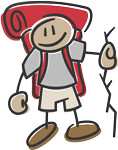 Do you draw conclusions based on evidence? Do you develop arguments based on facts rather than emotions? Do you pick a the winner of a debate on how the speaker looks and sounds or on their reasoning? Young people often writing reports that end in a conclusion. Where does this conclusions come from? Solid evidence and convincing arguments or past experience, belief systems, peer pressure, or emotions?
Do you draw conclusions based on evidence? Do you develop arguments based on facts rather than emotions? Do you pick a the winner of a debate on how the speaker looks and sounds or on their reasoning? Young people often writing reports that end in a conclusion. Where does this conclusions come from? Solid evidence and convincing arguments or past experience, belief systems, peer pressure, or emotions?
 Deanna Kuhn (2005) suggests that we need an "argument curriculum" that engages young people in reasoning activities. She suggests the following areas (Kuhn, 2005, 154-154):
Deanna Kuhn (2005) suggests that we need an "argument curriculum" that engages young people in reasoning activities. She suggests the following areas (Kuhn, 2005, 154-154):
- Generating Reasons - Reasons underlie opinions; different reasons may underlie the same opinion
- Elaborating Reasons - Good reasons support opinions
- Supporting Reasons with Evidence - Evidence can strengthen reasons
- Evaluating Reasons - Some reasons are better than others
- Developing Reasons into an Argument - Reasons connect to one another and are building blocks of argument
- Examining and Evaluating Opposing Side's Reasons - Opponents have reasons too
- Generating Counterarguments to Others' Reasons - Opposing erasons can be countered. We can fight this
- Generating Rebuttals to Others' Counterarguments - Counters to reasons can be rebutted. We have a comeback
- Contemplating Mixed Evidence - Evidence can be used to support different claims
- Conducting and Evaluating Two-sided Arguments - Some arguments are stronger than others
Seek books, articles, movies, songs, and other resources that take different perspectives on a topic, issue, or historical event. Ask students to apply evidence to reason and their own draw conclusions.
 Believer or Skeptic?
Believer or Skeptic?
Read the book Tales of the Cryptids by Kelly Milner Hall, Rick Spears, and Roxyanne Young. Also check out the online teacher resources.
Student Resources
- Mythic Creatures: Dragons, Unicorns & Mermaids from American Museum of Natural History
- Strange Science
- World Myths and Legends in Art
Teacher Resources
- Unicorns, Dragons, and Other Magical Creatures (Grades K-2)
For more fun, read Sally M. Walker's Fossil Fish Found Alive (Carolrhoda, 2002), Richard Ellis's The Search for the Giant Squid (Lyons, 1998), Kathy Darling's Komodo Dragon on Location (Lothrop, 1997), and Christopher Maynard's Micromonsters (DK, 1999).
Are you a Believer or a Skeptic? Pick a creature from the book. Trace the headwaters. Share your results on a wiki. Classmates use the DISCUSSION tab to add their opinion.
Go to the Unsolved Mysteries wikispace for an example.
Making Evidence Real
 In order for young people to understand information, they need to experience all aspects of information inquiry. Rather than simply being consumers, they need to be participants in the creation and sharing of information.
In order for young people to understand information, they need to experience all aspects of information inquiry. Rather than simply being consumers, they need to be participants in the creation and sharing of information.
Children at the University Elementary School in Bloomington, Indiana conducted a community inquiry to understand the culture of their students, families, and community. For instance, the children surveyed students about culture and art in the community. They then created web pages to share their charts and graphic, photos, videos, and text.
An Indiana teacher brought a cotton plant into the classroom. Rather than a direct instruction approach, she chose an inquiry-based approach. Young people generated the questions: What kind of plant is this? How fast does it grow? How can we tell if something is made from cotton? The children collected, analyzed, challenged, and applied their evidence to draw their own conclusions about the plant and it's role in their lives. They used books and other resources, but they also measured the plant, took photographs, and recorded their results.
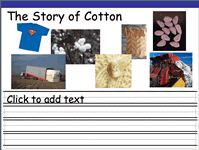
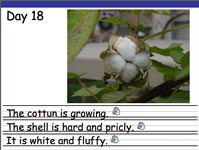
Books
- Biography of Cotton by Carrie Gleason
- Cotton by by Chris Oxlade
- A Cotton T-Shirt by Sarah Ridley
- From Plant to Blue Jeans : A Photo Essay by Arthur John L'Hommedieu
- Up before Daybreak: Cotton and People in America by Deborah Hopkinson
Websites
- National Cotton Council - for teachers
- Cotton Harvesting - videos
- Cotton in My Jeans (Grades 3-5) WebQuest
- Cotton's Journey - for children and their teachers
- Cotton Info
- History of Cotton
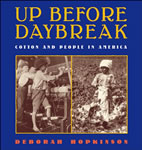
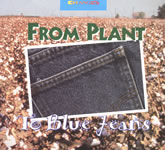
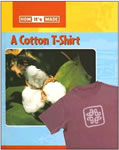

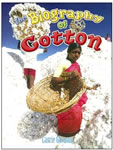
Resources
Daniel Callison and Leslie Preddy (2006) The Blue Book on Information Age Inquiry, Instruction, and Literacy, Libraries Unlimited, 2006.
Daniel Callison and Annette Lamb (2006) "The Capital Cs to Challenge Evidence" in The Blue Book on Information Age Inquiry, Instruction, and Literacy (Callison and Preddy), Libraries Unlimited, 2006.
Deanna Kuhn. Education for Thinking. Harvard University Press, 2005.
Special Thanks to Lois Oyer for the grade stories from her first grade class.
Want to learn more? Go to Information Inquiry or Teacher Tap.